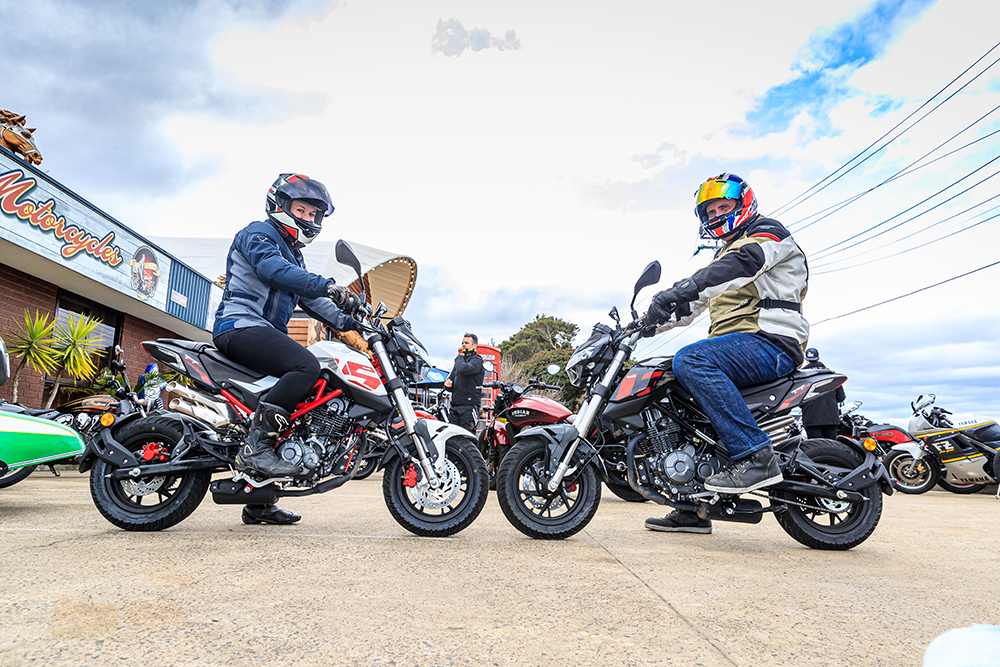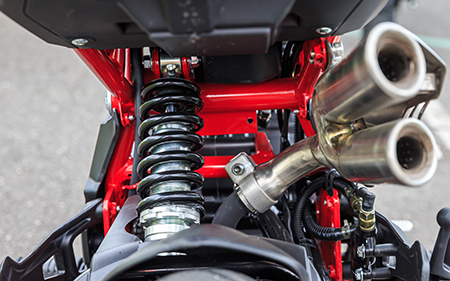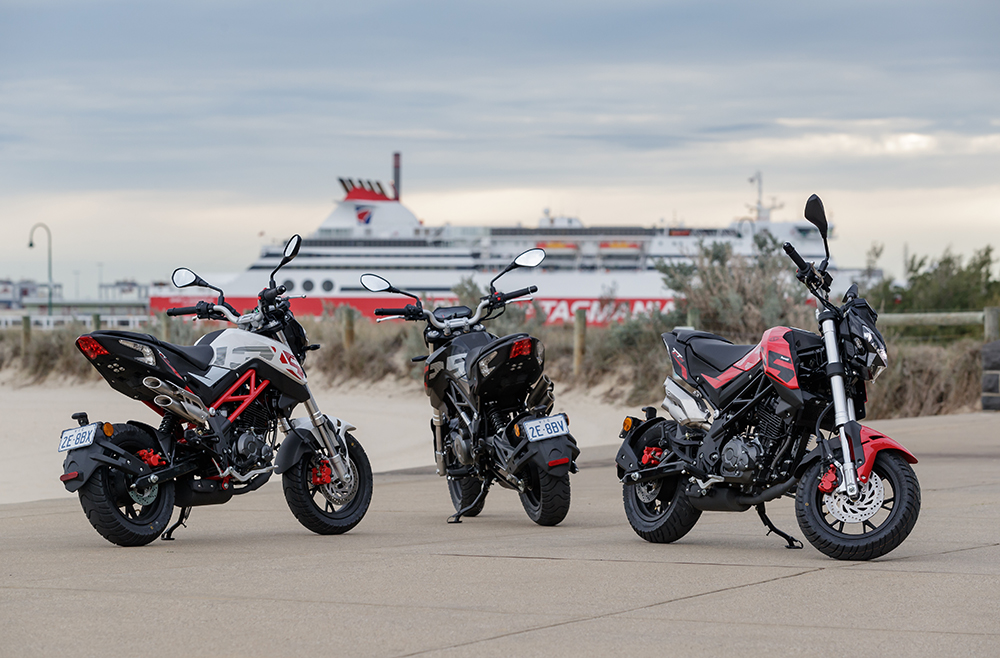You’re probably wondering what the point is. Benelli had a perfectly good little-big-bike in its TnT 125 (AMCN Vol 67 No 09). Perfectly good in that not only did it boast many superior specs over its Honda Grom and Kawasaki Z125 Pro rivals, it was less expensive, too.
How then, just 18 months later, does a savvy distributor like Urban Moto Imports justify the added marketing costs and ADR hoop jumping associated with introducing what is essentially the same bike to market, just with 10 extra cubes?
Sitting astride the new bike you wouldn’t know it wasn’t the firm’s existing 125cc variant. The quality of finish belies its sub-$4K price tag in every way; from the smallest details like the Japanese-esque switch blocks right through to the oh-so European styling cues. Touches like the trellis frame, dual-exit side-mounted exhaust and fully integrated rear indicators are everything a low-capacity Chinese-built commuter bike isn’t. But it’s a trend we’re getting used to from the 108-year-old brand, which has two 250cc GP world championships to its name, including one in the hands of Australian Kel Carruthers in 1969.
Benelli has been under Chinese firm Qianjiang Group’s ownership since 2005 and it has spent the last 15 years honing its ability to churn out top-quality machinery off its southeast Asian production lines, machinery that has been designed in Benelli’s spiritual home in Pesaro, Italy. It’s both successful and cost effective, and what it means for the end user is the only thing that really screams ‘Chinese’ is the price. If you’re not a brand loyalist and you’re in the market for a little-big-bike, compare it to its rivals on paper (which is what we’ll have to do until Sam organises a comparo) and it’ll be hard to go past.

It boasts a four-valve head compared to the Grom and Zed’s two-valve head, which makes for a freer-breather and, in theory, a cleaner combustion. It’s got five gears compared to both the Japanese-branded, Thailand-built offerings’ four-cog affairs and that just adds much-needed versatility to small-capacity engines like these. They all boast an upside-down front fork, but the Benelli’s 41mm stanchions are a full 10mm larger diameter than the Honda’s 31mm fork legs and 11mm larger than the Zed’s. And with a claimed 9.5kW (13hp) and 10.8Nm, it has it over the Honda and Kawasaki in terms of outright numbers, too, which are 7.2kW/10.7Nm and 7.1kW/8.0Nm respectively.
What it all adds up to is its only stumbling block – its weight. It tips the scales at 124kg ready to ride, 20-odd kilograms heavier than the Honda (104kg) and the Kawasaki (101kg). But release the clutch and accelerate away and, as you’d expect, the last thing this bike feels is heavy. In fact it’s the accelerating-away bit that makes the most sense about the 135cc machine. You wouldn’t expect 10 extra cubes to make that much of a difference, but it really does, and it makes really good sense.
If you’ve not ridden one of these little-big-bikes before, you’ll be surprised at how vulnerable you don’t feel. Not surprisingly, you’re the most comfortable when you’re up to speed and perched atop the conventional height seat – the TnT 135 has the same 780mm seat height as Yamaha’s MT-03, for example – aside from the 12-inch wheels, when you’re moving steadily with the traffic, it’s as if you’re riding any other learner-approved machine.
But it’s the accelerating away bit that’s important. Be it off the line when the lights go green, or when you change lanes and try and pass a vehicle, these small-capacity bikes can really raise your heart rate. And it was after the first 30 or so minutes of a two-hour road ride that I began to understand why Benelli Australia went to all that effort. Ten cubes doesn’t seem like much on paper, but it’s nearly 10 percent. When you consider it’s more or less the same jump BMW made between its old 1170cc horizontally opposed twin and its new 1250cc version, then in relative terms it’s both relevant and significant. And, most importantly, it’s a noticeable improvement exactly where it matters most.


The other significant change over the 125cc machine is that this new one doesn’t have the linked braking system that the outgoing model did. Deactivating the system was a conscious move by the importer, it says, based around bringing the TnT in line with its Honda and Japanese competitors.
There’s no ABS, but there’s no regulation here or anywhere else that mandates it. And, while I’m a supporter of ABS on all motorcycles, the TnT 135 doesn’t really need it. Aside from adding unwanted heft, the dual-piston caliper biting the lone 220mm front disc has plenty of feel and power for its application, especially coupled with the single-piston caliper and 190mm disc at the rear. And, judging by the length of the skids or the well-executed stoppies that would rival Jack Miller’s very impressive Silverstone effort, at the approach to each red light by the foolhardy fellows accompanying me, no one seemed to miss the linked brakes either.
The same foolhardy fellows accompanied me to the local go-kart track, too, and while there’s not a lot of things more entertaining than some big names of the two-wheeled sporting world fighting for the same piece of tight and undulating tarmac, it highlighted good and not-so god bits of the new Benelli really well.
On the road, which is exactly where this bike is meant to be, there’s nothing wrong with the Cordial-branded tyres which adorn the TnT 135. The 120/70 profile front feels familiar and intuitive – helped by that solid 41mm USD fork – but doesn’t offer a heap of confidence when you dig it into a tight apex on track.
Speaking of digging in, the bikes were considerably lighter by the day’s end, thanks to the sidestand mount and footpegs being ground down – again, if your grinding away metal on the road, you’re probably doing it wrong.

The offset rear shock which is adjustable for preload is more than up for the tomfoolery, too, and on the road the front and rear package works effectively together to offer predictability over the rough stuff and has none of that jarring or hollow feeling often associated with bikes in this price and capacity segment.
The pillion seat is a generous size given the likelihood of how many owners actually utilising it. It does offer practicality in terms of luggage capacity however, as I found out during my long-term stint with the now-superseded 125 (AMCN Vol 67 No 09) when I took it camping, took it fishing, did the grocery shopping on it, as well as ferried the kids to school and back. It’s a bike that’s far more practical than it looks.
Despite its $3990 ride away price tag, it boasts LED lighting all ’round and has a basic but informative LED dash offering a fuel gauge and a clock – two things every bike should have but don’t always – as well as the standard speed, odometer and two trip meters.
For the rider who wants to dip their uninitiated toe into motorcycle waters, there’s no better, or less intimidating way to do it. And for the seasoned rider who needs a time- and fuel-efficient way to commute to work, there probably isn’t a more fun way to do it.
And when you can ride away on the thing with two years roadside assist and still get change out of $4000, there’s probably not too many more economical ways to do it, either.

Test Kel Buckley Photography Mark Dadswell











